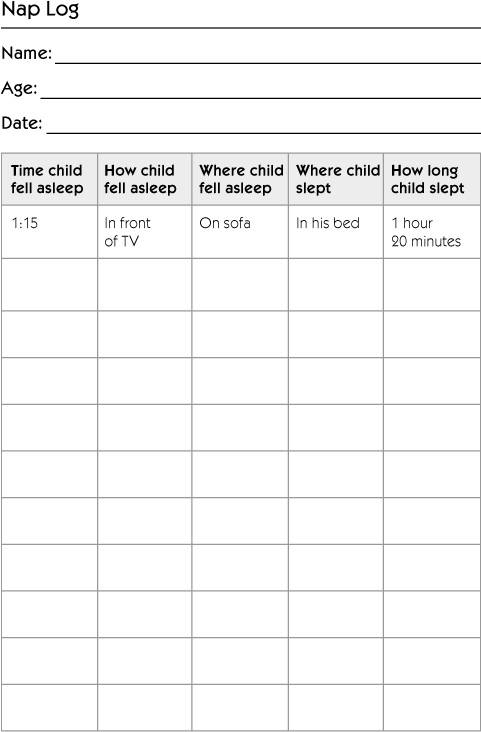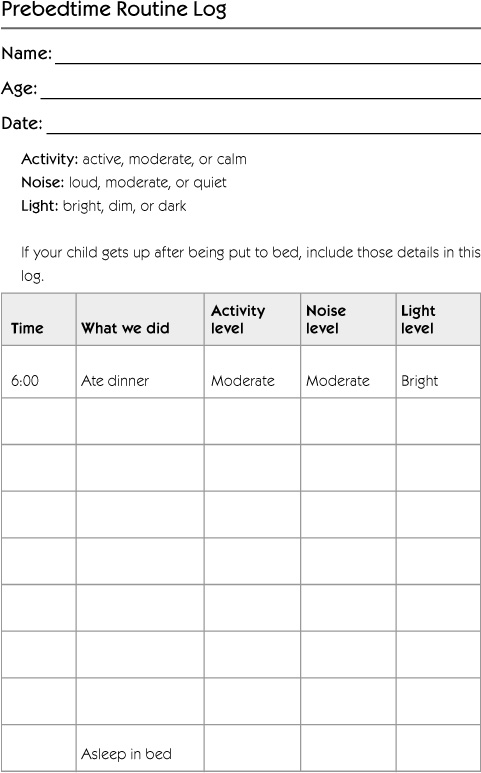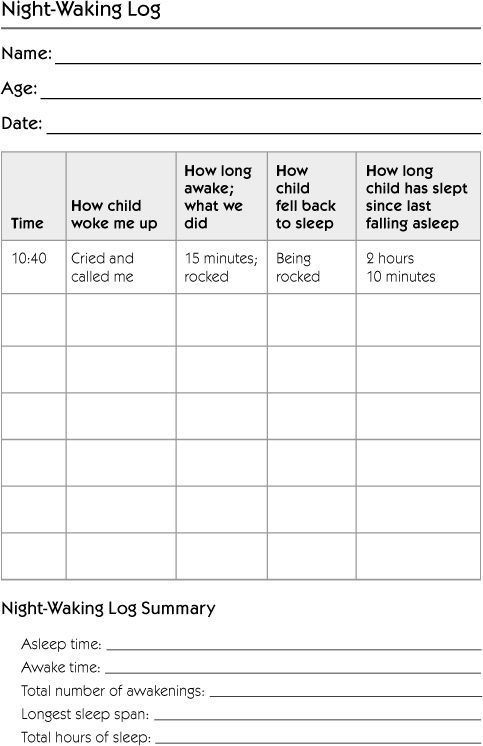
When you first begin to work on improving your child's sleep, it can be helpful to pick one typical day and night and create logs to record your child's current sleeping patterns. These logs can help you analyze how your child is sleeping now and will help you determine which ideas best apply to your situation. The other advantage of doing these logs is that you'll have a baseline for judging the effectiveness of your sleep plan. By doing one new set of logs every two to four weeks, you'll be able to see just how your little one's sleep routines are changing, and thus be better able to make adjustments in your plan, if you need to.
The logs are intended to help you through the process and should give you a feeling of control over what now may be an out-of-control situation. They are a tool to guide you through the process of change.
If, however, you have log-phobia, or if one look at them gives you hives, then by all means skip the logs and go directly to creating your plan. The last thing I want to do is create any stress for you. Many parents find, however, that making one day's logs every two to four weeks helps them better understand how their child is sleeping, which leads to clearer decisions about what needs to change and how implemented changes are working. Don't be tempted to log any more frequently than every two weeks, though, as you might create unnecessary tension for your child and yourself over sleep issues.
What follows are three logs: naptime, prebedtime routine, and night waking. Each one shows a sample entry. (These can also be found on my website at nocrysleepsolution.com.) Following the logs are lists of questions to help you evaluate your child's sleep patterns and a worksheet to help you set a plan.

Satoshi, one year old, and Elise, two years old
The nap log is important not just as it relates to naps but also because daytime sleep has a very powerful effect on nighttime sleep. The log will show how long it takes your child to fall asleep, where and how he falls asleep, and when and how long he naps— which will all be valuable to analyze as you put your plan together.
The prebedtime routine log will help you see how evening activities either help relax your child for bed or hinder your little one's ability to settle down for a good night's sleep. For this log, simply record the activities your child is engaged in and the environment surrounding the activity from roughly two hours before bedtime until the time he is actually asleep in his bed.
The night-waking log will display how many times your child wakes up, what you do when he does, how long your child is awake, and how long his sleep stretches are between awakenings. (It's easiest to place a pencil and pad near your bed and scratch down the information during the night, then transfer it to the form in the morning.)
All of these logs will direct you toward your best solutions and help you monitor your progress.



Take some time to review the logs you've created as well as the sleep facts in Part I and read the eight tips in Part II. Then answer the following questions:
1. Review Table 1.2 on page 12:
How many hours of nighttime sleep should your child be getting?_____
How many hours of nighttime sleep is your child getting now?_____
How many hours of daytime sleep (naps) should your child be getting?_____
How many hours of daytime sleep (naps) is your child getting now?_____
How many total hours of sleep should your child be getting?_____
How many total hours of sleep is your child getting now?_____
How do the suggested hours of sleep in the table compare to your child's actual hours of sleep?_____
Gets_____hours too little daytime sleep
Gets_____hours too much daytime sleep
Gets_____hours too little nighttime sleep
Gets_____hours too much nighttime sleep
2. Does your child have any of the signs of sleep deprivation listed on pages 12 and 13?_____How many?_____
3. Does your child have a wind-down or quiet time before bed?_____
4. Is the hour prior to bedtime mostly peaceful, quiet, and dimly lit?_____
5. Is your child's bedtime consistent (within a half hour) every night?_____
6. Do you have a formal, reliable bedtime routine (one that has a specific ending task and an ending "lights out" time)?_____
7. Are the foods that your child eats for a prebedtime snack the right quantity and type to induce a feeling of calm and drowsiness?_____(See Tip 6, on pages 82 and 83.)
8. Does your bedtime routine help your child relax and get sleepy?_____
9. Is your child's sleep environment conducive to a good night's sleep?_____(See Tip 5, on page 65.)
10. Do you "help" your child go back to sleep every time or nearly every time he or she awakens?_____
11. What things do you do for your child (breastfeed, rock, provide a bottle, etc.)?_____
12. Does your child wake up at roughly the same time (within a half hour) every morning?_____
13. Does your child get adequate daily physical activity to feel tired at the day's end?_____
14. What have you learned about your child's sleep patterns by doing these logs and answering these questions? What problems do you see? What do you think needs to be changed?
________________________________________________________________________________________________________
________________________________________________________________________________________________________
________________________________________________________________________________________________________
________________________________________________________________________________________________________
________________________________________________________________________________________________________
________________________________________________________________________________________________________
________________________________________________________________________________________________________
________________________________________________________________________________________________________
________________________________________________________________________________________________________
________________________________________________________________________________________________________
________________________________________________________________________________________________________